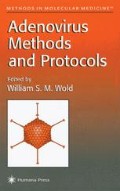Abstract
Adenoviruses carry their DNA genome into postmitotic nuclei of a variety of human cells, either within an organism (in vivo) or outside an organism in culture (ex vivo) (1). Recombinant adenoviruses are developed m many laboratories as gene-delivery vehicles to treat hereditary and acquired human disorders of somatic cells (2,3). Diseased lungs of cystic fibrosis patients have been pioneered for treatment with recombinant adenovirus vectors (4) Preliminary results are promising, but demonstrate that the disease has not yet been cured by the emerging gene transfer technology (5). One reason for limited success was that the transgenes were not expressed adequately in the diseased tissues, either because of low efficiency of virus delivery to the target cell or inefficient DNA import into the nucleus. In this chapter, we describe a quantitative method to determine transport of fluorescently labeled wild-type adenovirus 2 to the nucleus of a model cell line, HeLa cells. This protocol should be directly applicable to recombinant adenoviruses in a variety of cell lines, including peripheral blood cells, fibroblasts, polarized epithelial cells, and differentiated neurons.
Access this chapter
Tax calculation will be finalised at checkout
Purchases are for personal use only
References
Mulligan, R. C. (1993) The basic science of gene therapy. Science 260, 926–932.
Trapnell, B. C. and Gorziglia, M. (1995) Gene therapy using adenoviral vectorsCurr. Op Btotech 5, 617–625.
Hanama, E. G., Kavanagh, J., Hortobagyi, G., Giles, R. E., Champlin, R., and Deisseroth, A. B. (1995) Recent advances in the applicatton of gene therapy tohuman disease Am J Med 99, 537–552.
Rosenfeld, M. A., and Collins, F. S. (1996) Gene therapy for cystic fibrosis Chest 109, 241–252
Crystal, R. G.(1995) Transfer of genes to humans: early lessons and obstacles to success Science 270, 404–410.
Horwitz, M. S.(1990) Adenovirtdae and their replication, in Virology, vol 1 (Fields, B N. and Knipe, D. M., eds.), Raven, New York, pp 1679–1721
Stewart, P. L., Fuller, S. D., and Burnett, R. M. (1993) Difference imaging ofadenovirus bridging the resolutron gap between x-ray crystallography and electron microscopy. EMBO J 12, 2589–2599.
Greber, U. F., Willetts, M., Webster, P., and Helenius, A. (1993) Stepwtse dts-mantling of adenovuus 2 during entry mto cells. Cell 75, 477486.
Bergelson, J. M., Cunnmgham, J. A., Droguett, G., Kurt-Jones, E. A., Krithtvas, A., Hong, J. S., Horwttz, M. S., Crowell, R. L., and Finberg, R. W. (1997) lsolation of a common receptor for Coxsackte B vnuses and adenovnuses 2 and 5 Sczence 275, 1320–1323
Tomko, R. P., Xu, R., and Philipson, L. (1997) HCAR and MCAR the humanand mouse cellular receptors for subgroup C adenoviruses and group B cox-sackieviruses Proc Nat1 Acad Ser. USA 94, 3352–3356.
Hong, S. S., Karayan, L., Tournier, J., Curiel, D. T., and Boulanger, P. A. (1997) Adenovnus type 5 fiber knob binds to MHC class I alpha2 domam at the surfaceof human epithehal and B lymphoblastoid cells. EMBO J. 16, 2294–2306
Huang, S., Kamata, T., Takada, Y., Ruggeri, Z. M., and Nemerow, G. R (1996) Adenovirus interaction with distinct integrins mediates separate events in cellentry and gene delivery to hematopoietic cells. J. Virology 70, 4502–4508.
Wickham, T. J., Mathtas, P., Cheresh, D. A., and Nemerow, G. R. (1993) Integrms alpha v beta 3 and alpha v beta 5 promote adenovtrus mternalization but not virus attachment. Cell 73, 309–319
Greber, U. F., and Kasamatsu, H. (1996) Nuclear targeting of SV40 and adenovirUS. Trends Cell Biol 6, 189–195.
Wrckham, T. J., Ftlardo, E J., Cheresh, D. A., and Nemerow, G. R. (1994) Integrm alpha v beta 5 selectively promotes adenovirus mediated cell membrane permeabihzation. J Cell Btol 127, 257–264.
Pastan, I., Seth, P., FitzGerald, D., and Willingham, M. (1986) Adenovnus entry into cells. some new observatrons on an old problem, in Concepts in Viral Pathogenesis II (eiNotkins, A. L., and Oldstone, M. B. A., eds.), Springer Verlag, New York, pp. 141–146
Greber, U. F., Webster, P., Weber, J., and Helemus, A. (1996) The role of the adenovnus protease on virus entry into cells. EMBO J 15, 17661777
Gürlich, D., and Mattaj, I. W. (1996) Nucleocytoplasmic transport Science 271, 1513–1518.
Harlow, E., and Lane, D. (1988) Antzbodzes, A Laboratory Manual (Harlow, E, L., ed), Cold Spring Harbor Laboratory, Cold Spring Harbor, NY.
Nevms, J. R. (1981) Definition and mappmg of adenovnus 2 nuclear transcription. Methods Enzymol. 65, 768–785.
Malzel, J. V. J., White, D. O., and Scharff, M D. (1968) The polypeptides of adenovnus. I. Evidence for multiple protein components in the vnion and comparison of types 2, 7A, and 12. Virology 36, 115–126
Chardonnet, Y., and Dales, S. (1970) Early events in the interaction of adenoviruses with HeLa cells. I. Penetration of type 5 and intracellular release of the DNA genome virology 40, 462–477
Ginsberg, H. S. (1984) The Adenovlruses. Plenum, New York.
Laemmli, U. K. (1970) Cleavage of structural protems during the assembly of the head of bacteriophage T4 Nature 227, 680–685
Berns, K. I. (1996) Parvoviridae the viruses and their rephcatron, in Fundamental Vzrology (Fields, B. N., Kmpe, D. M., and Howley, P. M., eds), Raven, Philadelphia, pp. 1017–1041
Lacey, A. J. (1991) The princtples and aims of light microscopy, in Light Microscopy in Biology, A Practical Approach (Lacey, A. J., ed), Oxford University Press, Oxford, England, pp 1–59
Author information
Authors and Affiliations
Editor information
Editors and Affiliations
Rights and permissions
Copyright information
© 1999 Humana Press Inc., Totowa, NJ
About this protocol
Cite this protocol
Greber, U.F., Nakano, M.Y., Suomalainen, M. (1999). Adenovirus Entry into Cells. In: Wold, W.S.M. (eds) Adenovirus Methods and Protocols. Methods in Molecular Medicine™, vol 21. Springer, Totowa, NJ. https://doi.org/10.1385/0-89603-551-4:217
Download citation
DOI: https://doi.org/10.1385/0-89603-551-4:217
Publisher Name: Springer, Totowa, NJ
Print ISBN: 978-0-89603-551-5
Online ISBN: 978-1-59259-603-4
eBook Packages: Springer Protocols

